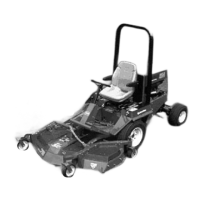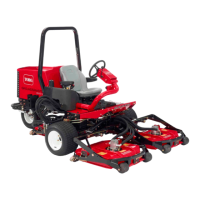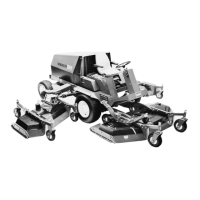PERIODIC MAINTENANCE
Tighten the nut finger tight until it bottoms
against the seat (Fig. 8).
B
Figure 8
With an ink pen or marker, mark a line
lengthwise on the nut and adapter (See
Fig. 8).
c.
4. Remove the tube that connects the axle housing
and transmission (Sundstrand), or the axle housing
and filter (Vickers) and allow the oil to flow into a
drain pan.
5. Fill the new hydraulic oil filter with fresh 10W30
or 10W40 oil and install the filter onto the bottom of
the transmission or filter mounting pad.
6. Install the tube between the axle housing and
transmission/filter mounting pad.
7. Fill the axle (reservoir) to the proper level; refer
to "Checking Oil Level," page 10.
8. Start the engine and operate at an idle for about 5
minutes. Turn the engine off.
9. Allow the machine to sit for about 2 minutes.
After two minutes have passed, check the level of
the oil in the axle. If the level is low, add oil to
achieve the proper level. If the level is too high,
drain some of the oil until it is at the correct level;
refer to "Checking Oil Level," page 10.
Figure 9
Hold the adapter with a wrench and tighten
the nut the number of flats indicated in the
chart on page 14, according to the hose
size (Fig. 9). This should secure the
connection.
D.
2. SAE Straight Thread Q-ring Seal
A.
Assure
that the connecting parts are
clean. Sand, grass, or other contaminants
will prevent a good seal and may damage
the O-ring. The O-ring is the most impor-
tant part in this type of connection as it
serves as the main seal of the connection
(Fig. 10).
~
~
HYDRAULIC LINES AND FITTINGS
Lines and fittings are the "linkages" that tie the
components of the hydraulic system together. They
must carry the fluid without leaking, under pres-
sures of perhaps 1,000 to 4,000 psi (6895 to 27580
kPa) or more.
In order for these parts to do their job, it is necessary
that they be in good condition, mounted and routed
correctly, and properly tightened.
A daily inspection should include:
1. Check for clearance; lines should not rub against
another line or part.
2. Check for poor physical condition; look for
cracks, abrasions, swelling, and deterioration.
3. Check for bends, dents, and kinks; too much
fluid flow restriction may cause overheating and
slow operation.
4. Look for signs of oil leakage.
Figure 10
B.
The correct method for tightening hydraulic fittings
should be followed at all times:
1. SAE Flare Connections
A. Assure that the two connecting parts are
clean. Sand, grass or other contaminants
will prevent a good seal, no matter how
tight the fitting is torqued.
c,
Always replace the a-ring seal when this
type fitting shows signs of leakage.
The jam nut and washer must be to the
back side of the smooth portion of the
elbow adapter (Fig. 11).
5.12
Rev. 1985

